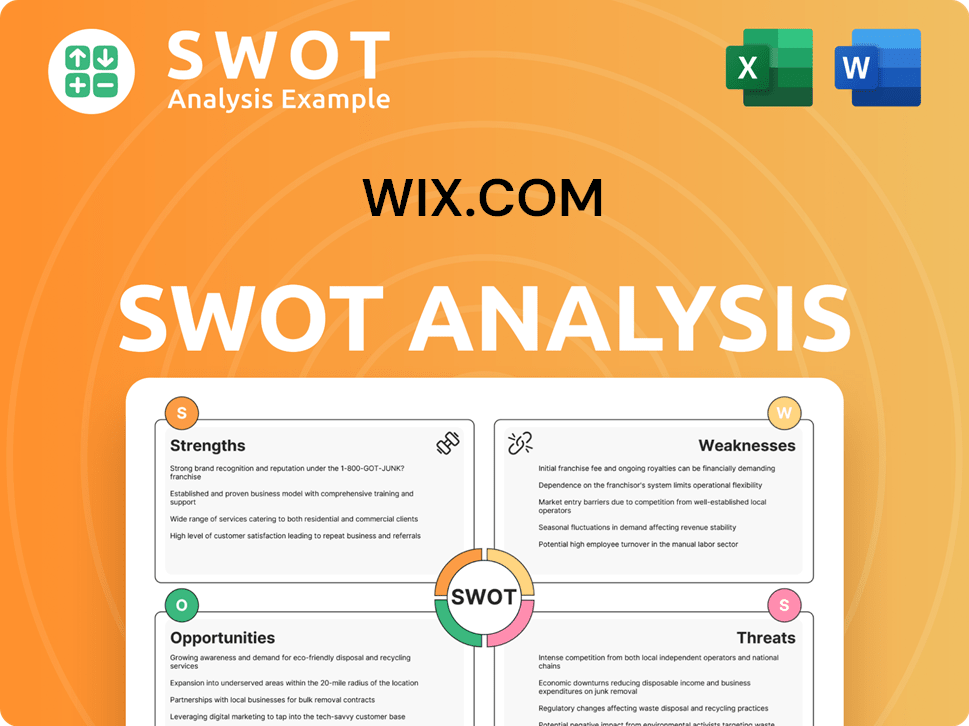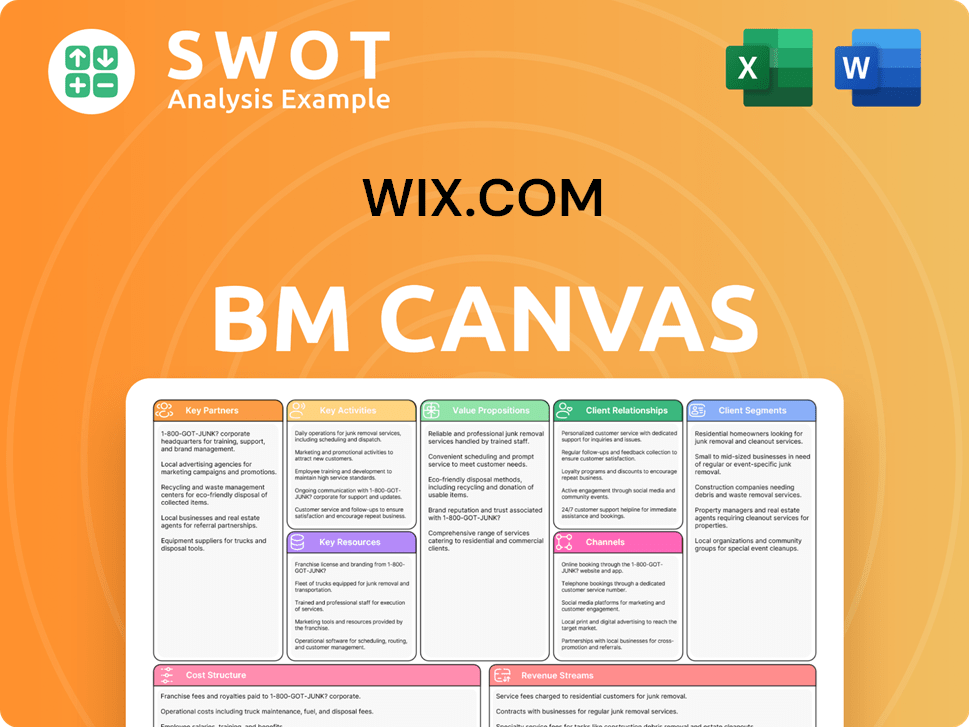Wix.com Bundle
How Did Wix.com Revolutionize Web Design?
Imagine a world where building a professional website was as simple as dragging and dropping. That's the promise Wix.com delivered, transforming web design from a complex skill to an accessible tool for everyone. This Wix.com SWOT Analysis delves into the fascinating journey of a company that democratized the internet.

Founded in 2006, the Wix company quickly became a leading online platform, initially focusing on Flash-based websites. The evolution of Wix platform is a testament to its adaptability and commitment to user empowerment. From its early days to its current status as a comprehensive website builder, Wix's history is a compelling story of innovation and market dominance.
What is the Wix.com Founding Story?
The story of Wix.com begins on October 2, 2006, with its founding by three Israeli entrepreneurs: Avishai Abrahami, Nadav Abrahami, and Giora Kaplan. This marked the inception of what would become a leading online platform for web design and website building. Their collective expertise in software development, product management, and technical architecture laid the groundwork for a user-friendly solution in a market that was then dominated by complex and costly web development processes.
The founders identified a critical gap in the market: the difficulty small businesses and individuals faced in creating professional websites. The initial vision was to simplify web creation, making it accessible to everyone, regardless of their technical skills. This ambition drove the development of a drag-and-drop website builder, allowing users to design and publish websites without writing any code.
The company's name, 'Wix,' was chosen for its simplicity and memorability, reflecting the ease of use the platform aimed to provide. Early funding from investors like Bessemer Venture Partners, Mangrove Capital Partners, and Benchmark Capital supported the initial development and growth. The founding team's combined skills were essential in navigating the early challenges of establishing a new web development platform.
Here's a quick overview of Wix's founding:
- Founding Date: October 2, 2006.
- Founders: Avishai Abrahami, Nadav Abrahami, and Giora Kaplan.
- Initial Focus: Providing a free, easy-to-use platform for creating Flash-based websites.
- Initial Funding: Seed round with investments from Bessemer Venture Partners, Mangrove Capital Partners, and Benchmark Capital.
- Core Innovation: A drag-and-drop website builder that allowed users to design and publish websites without coding.
Wix.com SWOT Analysis
- Complete SWOT Breakdown
- Fully Customizable
- Editable in Excel & Word
- Professional Formatting
- Investor-Ready Format

What Drove the Early Growth of Wix.com?
The early growth of the Wix.com company was marked by its appeal as an accessible website builder. Founded in 2006, the
In 2009, the
A crucial strategic decision was made in 2010 to transition from Flash to HTML5, broadening the platform's appeal. This involved a complete rebuild of the editor and infrastructure. The HTML5 editor launched in 2012, marking a new phase of growth for the
By 2013, the
The early success of
Wix.com PESTLE Analysis
- Covers All 6 PESTLE Categories
- No Research Needed – Save Hours of Work
- Built by Experts, Trusted by Consultants
- Instant Download, Ready to Use
- 100% Editable, Fully Customizable

What are the key Milestones in Wix.com history?
The journey of the Wix.com company, from its inception, has been marked by significant milestones and continuous evolution in the web design landscape. This Wix history is a testament to its adaptability and commitment to providing user-friendly tools for creating online presences.
| Year | Milestone |
|---|---|
| 2006 | Wix was founded by Avishai Abrahami, Nadav Abrahami, and Giora Kaplan, with the goal of making web design accessible to everyone. |
| 2010 | Wix launched its first version, offering a Flash-based website builder. |
| 2012 | The company introduced its HTML5 editor, marking a significant technological shift and enabling long-term growth. |
| 2012 | The Wix App Market was launched, expanding the platform's functionality with third-party applications. |
| 2013 | Wix went public on the NASDAQ, trading under the ticker symbol WIX. |
| 2014 | Wix ADI (Artificial Design Intelligence) was introduced, automating website creation and simplifying the design process. |
| 2023 | Wix reported reaching over 250 million registered users globally, highlighting its widespread adoption. |
| 2024 | Wix continues to enhance its platform with AI-driven features and robust e-commerce solutions. |
Throughout its evolution, Wix.com has consistently introduced innovative features to enhance user experience and expand its capabilities as a website builder. These innovations have played a crucial role in shaping the Wix company into a leading online platform for web design.
The shift to an HTML5 editor in 2012 was a pivotal innovation, enabling greater flexibility and compatibility across devices. This move was essential for keeping up with the evolving web standards.
The introduction of the Wix App Market in 2012 allowed third-party developers to create apps, significantly enhancing the platform's functionality. This expanded the ecosystem, offering users a wide array of tools.
Wix ADI, launched in 2014, revolutionized website creation by automating the design process based on user input. This simplified web design, making it accessible to a broader audience.
Wix has continuously improved its e-commerce capabilities, providing robust tools for businesses to sell products and services online. These tools include payment processing, inventory management, and shipping integrations.
In recent years, Wix has integrated more AI-driven features to enhance user experience and automate tasks. This includes AI-powered content creation and design suggestions.
Wix has consistently focused on mobile responsiveness, ensuring websites created on its platform are optimized for all devices. This includes offering mobile-friendly design options.
Despite its successes, Wix has faced several challenges in the competitive web design market. These challenges have pushed the company to adapt and innovate, ensuring its continued relevance and growth.
Intense competition from other website builders and content management systems has always been a significant challenge. This competition requires constant innovation and improvement to maintain market share.
Early on, Wix faced scrutiny regarding its SEO capabilities, but it has actively worked to improve these aspects. Continuous updates and enhancements have been made to optimize websites for search engines.
Adapting to the demands of mobile responsiveness has been an ongoing challenge, requiring constant updates to the platform. Wix has addressed this by offering mobile-friendly design options.
During the COVID-19 pandemic, Wix experienced a surge in demand, which presented the challenge of scaling its infrastructure. This required significant investment to meet the increased need.
The transition from Flash to HTML5 presented significant technical hurdles and required substantial investment. This was crucial for long-term growth, despite the initial challenges.
Responding to user feedback and market demands has been a continuous process. Wix actively works to improve its platform based on user input and evolving industry standards.
Wix.com Business Model Canvas
- Complete 9-Block Business Model Canvas
- Effortlessly Communicate Your Business Strategy
- Investor-Ready BMC Format
- 100% Editable and Customizable
- Clear and Structured Layout

What is the Timeline of Key Events for Wix.com?
The Wix.com company has a rich history marked by continuous evolution and strategic growth. Founded in 2006, the platform has consistently adapted to technological advancements and market demands, transforming from a basic website builder into a comprehensive online platform. Over the years, it has integrated advanced features, expanded its user base significantly, and made strategic acquisitions to enhance its offerings. This journey reflects its commitment to democratizing web creation and empowering users with cutting-edge tools.
| Year | Key Event |
|---|---|
| 2006 | Founded by Avishai Abrahami, Nadav Abrahami, and Giora Kaplan. |
| 2009 | Reached 1 million registered users. |
| 2010 | Announced the transition from Flash to HTML5 technology. |
| 2012 | Launched the HTML5 editor and the Wix App Market. |
| 2013 | Surpassed 34 million registered users and went public on NASDAQ (WIX). |
| 2014 | Introduced Wix ADI (Artificial Design Intelligence). |
| 2015 | Launched Wix Stores for e-commerce. |
| 2017 | Acquired the online art community DeviantArt. |
| 2018 | Introduced Corvid by Wix (now Velo by Wix), enabling advanced web development. |
| 2020 | Experienced significant user growth during the COVID-19 pandemic. |
| 2023 | Reported over 250 million registered users globally. |
| 2024 | Continued to focus on AI-driven feature enhancements and enterprise-level solutions. |
Wix is heavily investing in AI to personalize the website creation process. This includes features that optimize user experience and offer sophisticated business solutions. The focus is on making web design more accessible and efficient for all users. These enhancements are expected to drive user engagement and platform growth.
The company aims to strengthen its e-commerce platform to compete more effectively. This involves adding new features and improving existing ones to attract more online businesses. Recent data indicates a growing demand for robust e-commerce solutions. This expansion is key to capturing a larger market share.
Wix is expanding its enterprise offerings to attract larger clients. This includes providing more scalable and customizable solutions for bigger businesses. The goal is to cater to the needs of companies requiring advanced features and support. This strategic move aims to diversify the revenue streams.
The global website builder market is predicted to continue growing, driven by ease of use and comprehensive features. Wix is committed to maintaining its leadership position in the no-code/low-code web development space. The company's strategy aligns with the long-term vision of democratizing web creation.
Wix.com Porter's Five Forces Analysis
- Covers All 5 Competitive Forces in Detail
- Structured for Consultants, Students, and Founders
- 100% Editable in Microsoft Word & Excel
- Instant Digital Download – Use Immediately
- Compatible with Mac & PC – Fully Unlocked

Related Blogs
- What is Competitive Landscape of Wix.com Company?
- What is Growth Strategy and Future Prospects of Wix.com Company?
- How Does Wix.com Company Work?
- What is Sales and Marketing Strategy of Wix.com Company?
- What is Brief History of Wix.com Company?
- Who Owns Wix.com Company?
- What is Customer Demographics and Target Market of Wix.com Company?
Disclaimer
All information, articles, and product details provided on this website are for general informational and educational purposes only. We do not claim any ownership over, nor do we intend to infringe upon, any trademarks, copyrights, logos, brand names, or other intellectual property mentioned or depicted on this site. Such intellectual property remains the property of its respective owners, and any references here are made solely for identification or informational purposes, without implying any affiliation, endorsement, or partnership.
We make no representations or warranties, express or implied, regarding the accuracy, completeness, or suitability of any content or products presented. Nothing on this website should be construed as legal, tax, investment, financial, medical, or other professional advice. In addition, no part of this site—including articles or product references—constitutes a solicitation, recommendation, endorsement, advertisement, or offer to buy or sell any securities, franchises, or other financial instruments, particularly in jurisdictions where such activity would be unlawful.
All content is of a general nature and may not address the specific circumstances of any individual or entity. It is not a substitute for professional advice or services. Any actions you take based on the information provided here are strictly at your own risk. You accept full responsibility for any decisions or outcomes arising from your use of this website and agree to release us from any liability in connection with your use of, or reliance upon, the content or products found herein.